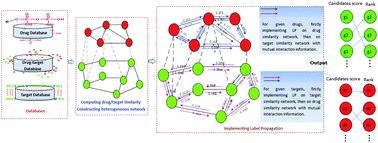Prediction of drug–target interaction by label propagation with mutual interaction information derived from heterogeneous network†
Abstract
The identification of potential drug–target interaction pairs is very important, which is useful not only for providing greater understanding of protein function, but also for enhancing drug research, especially for drug function repositioning. Recently, numerous machine learning-based algorithms (e.g. kernel-based, matrix factorization-based and network-based inference methods) have been developed for predicting drug–target interactions. All these methods implicitly utilize the assumption that similar drugs tend to target similar proteins and yield better results for predicting interactions between drugs and target proteins. To further improve the accuracy of prediction, a new method of network-based label propagation with mutual interaction information derived from heterogeneous networks, namely LPMIHN, is proposed to infer the potential drug–target interactions. LPMIHN separately performs label propagation on drug and target similarity networks, but the initial label information of the target (or drug) network comes from the drug (or target) label network and the known drug–target interaction bipartite network. The independent label propagation on each similarity network explores the cluster structure in its network, and the label information from the other network is used to capture mutual interactions (bicluster structures) between the nodes in each pair of the similarity networks. As compared to other recent state-of-the-art methods on the four popular benchmark datasets of binary drug–target interactions and two quantitative kinase bioactivity datasets, LPMIHN achieves the best results in terms of AUC and AUPR. In addition, many of the promising drug–target pairs predicted from LPMIHN are also confirmed on the latest publicly available drug–target databases such as ChEMBL, KEGG, SuperTarget and Drugbank. These results demonstrate the effectiveness of our LPMIHN method, indicating that LPMIHN has a great potential for predicting drug–target interactions.

- This article is part of the themed collection: Chemical Biology in Molecular BioSystems

 Please wait while we load your content...
Please wait while we load your content...